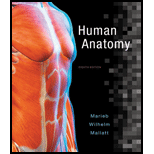
Human Anatomy (8th Edition)
8th Edition
ISBN: 9780134243818
Author: Elaine N. Marieb, Patricia Brady Wilhelm, Jon B. Mallatt
Publisher: PEARSON
expand_more
expand_more
format_list_bulleted
Question
Chapter 20, Problem 16RQ
Summary Introduction
To determine:
The problem that would not occur when the needle is inserted far too deeply into the cubital fossa instead of the median cubital vein, while trying to draw blood.
Introduction:
The blood is generally drawn out from the veins as they are directly present below the epidermis layer of the skin, while the arteries are located deep inside the skin. The median cubital vein, present in the upper limb, is most commonly used for venipuncture (taking blood) for sampling process. The cubital fossa is also known as antecubital fossa and is located in the anterior region of the elbow joint.
Expert Solution & Answer
Want to see the full answer?
Check out a sample textbook solution
Students have asked these similar questions
Please draw in the missing answer, thank you
Please fill in all blank questions, Thank you
please fill in missing parts , thank you
Chapter 20 Solutions
Human Anatomy (8th Edition)
Ch. 20 - What structural features of capillaries make them...Ch. 20 - Prob. 2CYUCh. 20 - Prob. 3CYUCh. 20 - Prob. 4CYUCh. 20 - Prob. 5CYUCh. 20 - Prob. 6CYUCh. 20 - Which vessel do you palpate to feel a pulse in...Ch. 20 - Name the vessels that branch off the abdominal...Ch. 20 - Prob. 9CYUCh. 20 - Prob. 10CYU
Ch. 20 - Prob. 11CYUCh. 20 - Prob. 12CYUCh. 20 - How does elevated blood glucose associated with...Ch. 20 - Prob. 14CYUCh. 20 - Prob. 15CYUCh. 20 - Prob. 1RQCh. 20 - Prob. 2RQCh. 20 - Prob. 3RQCh. 20 - Prob. 4RQCh. 20 - Which of the following vessels is bilaterally...Ch. 20 - Prob. 6RQCh. 20 - Prob. 7RQCh. 20 - Prob. 8RQCh. 20 - The following sequence traces the flow of...Ch. 20 - Prob. 10RQCh. 20 - The inferior mesenteric artery supplies the (a)...Ch. 20 - Prob. 12RQCh. 20 - Prob. 13RQCh. 20 - Prob. 14RQCh. 20 - Prob. 15RQCh. 20 - Prob. 16RQCh. 20 - (a) What structural features are responsible for...Ch. 20 - Prob. 18RQCh. 20 - Prob. 19RQCh. 20 - Sketch the arterial circle at the base of the...Ch. 20 - Prob. 21RQCh. 20 - Prob. 22RQCh. 20 - Prob. 23RQCh. 20 - Prob. 24RQCh. 20 - Differentiate between arteriosclerosis and...Ch. 20 - A pulse can be felt in the following arteries:...Ch. 20 - In an eighth-grade health class, the teacher...Ch. 20 - Prob. 2CRCAQCh. 20 - Prob. 3CRCAQCh. 20 - Prob. 4CRCAQCh. 20 - Prob. 5CRCAQCh. 20 - Prob. 6CRCAQCh. 20 - Occasionally, either the ductus arteriosus or the...Ch. 20 - Prob. 8CRCAQ
Knowledge Booster
Learn more about
Need a deep-dive on the concept behind this application? Look no further. Learn more about this topic, biology and related others by exploring similar questions and additional content below.Similar questions
- please draw in the answers, thank youarrow_forwarda. On this first grid, assume that the DNA and RNA templates are read left to right. DNA DNA mRNA codon tRNA anticodon polypeptide _strand strand C с A T G A U G C A TRP b. Now do this AGAIN assuming that the DNA and RNA templates are read right to left. DNA DNA strand strand C mRNA codon tRNA anticodon polypeptide 0 A T G A U G с A TRParrow_forwardplease answer all question below with the following answer choice, thank you!arrow_forward
- please draw in the answeres, thank youarrow_forwardA) What is being shown here?B) What is indicated by the RED arrow?C) What is indicated by the BLUE arrow?arrow_forwardPlease identify the curve shown below. What does this curve represent? Please identify A, B, C, D, and E (the orange oval). What is occurring in these regions?arrow_forward
- Please identify the test shown here. 1) What is the test? 2) What does the test indicate? How is it performed? What is CX? 3) Why might the test be performed in a clinical setting? GEN CZ CX CPZ PTZ CACarrow_forwardDetermine how much ATP would a cell produce when using fermentation of a 50 mM glucose solution?arrow_forwardDetermine how much ATP would a cell produce when using aerobic respiration of a 7 mM glucose solution?arrow_forward
- Determine how much ATP would a cell produce when using aerobic respiration to degrade one small protein molecule into 12 molecules of malic acid, how many ATP would that cell make? Malic acid is an intermediate in the Krebs cycle. Assume there is no other carbon source and no acetyl-CoA.arrow_forwardIdentify each of the major endocrine glandsarrow_forwardCome up with a few questions and answers for umbrella species, keystone species, redunant species, and aquatic keystone speciesarrow_forward
arrow_back_ios
SEE MORE QUESTIONS
arrow_forward_ios
Recommended textbooks for you
- Essentials of Pharmacology for Health ProfessionsNursingISBN:9781305441620Author:WOODROWPublisher:Cengage
 Comprehensive Medical Assisting: Administrative a...NursingISBN:9781305964792Author:Wilburta Q. Lindh, Carol D. Tamparo, Barbara M. Dahl, Julie Morris, Cindy CorreaPublisher:Cengage LearningBasic Clinical Lab Competencies for Respiratory C...NursingISBN:9781285244662Author:WhitePublisher:Cengage
Comprehensive Medical Assisting: Administrative a...NursingISBN:9781305964792Author:Wilburta Q. Lindh, Carol D. Tamparo, Barbara M. Dahl, Julie Morris, Cindy CorreaPublisher:Cengage LearningBasic Clinical Lab Competencies for Respiratory C...NursingISBN:9781285244662Author:WhitePublisher:Cengage - Surgical Tech For Surgical Tech Pos CareHealth & NutritionISBN:9781337648868Author:AssociationPublisher:Cengage

Essentials of Pharmacology for Health Professions
Nursing
ISBN:9781305441620
Author:WOODROW
Publisher:Cengage

Comprehensive Medical Assisting: Administrative a...
Nursing
ISBN:9781305964792
Author:Wilburta Q. Lindh, Carol D. Tamparo, Barbara M. Dahl, Julie Morris, Cindy Correa
Publisher:Cengage Learning

Basic Clinical Lab Competencies for Respiratory C...
Nursing
ISBN:9781285244662
Author:White
Publisher:Cengage


Surgical Tech For Surgical Tech Pos Care
Health & Nutrition
ISBN:9781337648868
Author:Association
Publisher:Cengage

Phlebotomy: Venipuncture Procedure; Author: Medical Lab Lady Gill;https://www.youtube.com/watch?v=LC9LABPts7M;License: Standard Youtube License